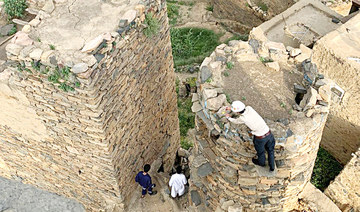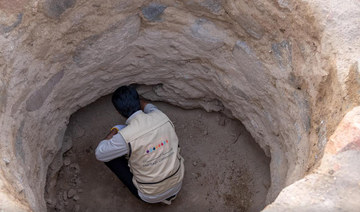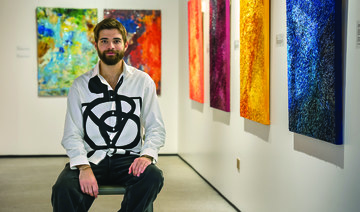DANDONG, China: Seated beneath tall windows and dressed simply in singlets and trousers, North Korean painters are hard at work. The artists staple canvases to frames or copy idyllic landscapes from laptop computers. One wears headphones as he brushes a group of running horses onto his canvas.
The nine men have come to the Chinese border town of Dandong from Mansudae Art Studio, North Korea’s largest producer of art. There are many outlets like this along the border; they house some of the thousands of North Korean artists who cater to burgeoning demand for their work. “Chinese have begun collecting art, and North Korean art is much easier and cheaper for them to obtain,” says Park Young-jeong, a research fellow at the Korea Culture and Tourism Institute, a Seoul-based organization.
In recent years as countries have responded to North Korea’s weapons tests with sanctions, Mansudae and other art studios have increasingly played a more controversial role – helping Pyongyang raise cash abroad. North Korea has long been punished for alleged underhand dealings in minerals, finance and arms; art was seen more as a channel for mutual understanding. That is changing.
Mansudae is run by the North Korean state. Its output ranges from statues of global leaders to propaganda posters, embroidery and more. It has built monuments and statues in at least 15 African countries, according to independent United Nations sanctions experts.
In a report in February, they said that a part of Mansudae called Mansudae Overseas Projects was a front for the North Korean state to cash in on military deals. As well as monumental statues, they found it built military installations such as a munitions factory and bases in Namibia.
The North Korean UN mission did not respond to a request for comment and no one from Mansudae could be reached.
The UN Security Council banned Mansudae’s statue business in 2016. On Aug. 5, after Pyongyang conducted more weapons tests, the Security Council blacklisted Mansudae Art Studio, subjecting it to a global asset freeze and travel ban. Diplomats say this will prevent Mansudae from conducting business.
“With this listing, anything Mansudae produces — including paintings, other artwork, monuments, buildings, and other construction — cannot be bought and should be frozen per the asset freeze,” said a UN Security Council diplomat, speaking on condition of anonymity.
In a further resolution on Sept. 11, the Security Council decided that all joint ventures with North Korean entities or individuals must be shut down within 120 days, or by mid-January.
Exactly what the measures mean for existing Mansudae art has yet to become clear. In Beijing’s art district, a gallery called the Mansudae Art Gallery says it is the studio’s official overseas gallery. Its head insists the sanctions do not apply to it and says they have had no impact on his business.
“Now more than ever we need avenues like art to create understanding between North Korea and the rest of the world,” said Ji Zhengtai.
It is not possible to estimate the total value of Mansudae’s dealings, but the Security Council diplomat said the business had earned tens of millions of dollars globally.
“WE DON’T DO POLITICS“
Mansudaeartsudio.com, a website in Italy which calls itself Mansudae’s “official website abroad,” says the studio is “probably the largest art production center in the world.”
Mansudae’s Pyongyang studio covers 120,000 sq m (nearly 30 acres), employs about 4,000 people including around 1,000 artists, and is divided into 13 creative groups, seven manufacturing plants and more than 50 supply departments, the website says.
The website is run by Pier Luigi Cecioni, who sells Mansudae works online and at fairs through what he calls an exclusive agreement with Mansudae Art Studio. He declined to say how much he sells, but in August after the sanctions on Mansudae Art Studio were announced, he told Reuters that the revenues go direct to the studio to pay for paints and equipment.
Cecioni said he sells works from his personal collection, most of them bought several years ago — before sanctions on Mansudae were announced. His website makes clear that any online purchase is made with his Italian company, not Mansudae. UN sanctions are not retroactive.
A panel of independent experts is charged with monitoring UN sanctions on North Korea. It reports violations and recommendations to the Security Council’s North Korea sanctions committee. Its reports are confidential, but the committee traditionally publishes annual reports.
Hugh Griffiths, who heads the panel, declined to comment, saying “the matter is subject to an ongoing investigation.”
Cecioni said, “the last thing I want is to have trouble with Italian or American authorities. I have strong contacts, especially with the Italian ones, and they help me to respect all the rules.” An Italian foreign ministry source said it is customary to keep contact with everyone who has ties to countries under sanctions, to ensure they respect Italy’s international commitments.
In September, Cecioni said that he had no plans to shut down his operation. “I consider it very important to let people know that ... North Koreans do not make only bombs but also art and are common people,” he said. He postponed an exhibition of propaganda posters he had planned for September in Treviso, but said this was because Mansudae’s representatives told him they thought it unwise to showcase their anti-US tone in the current climate.
Word of the sanctions has been slower to reach China. A circular from its Commerce Ministry announcing the start date of the measures which included Mansudae Art Studio does not name Mansudae. Asked why not, the ministry did not respond.
The Dandong center works in partnership with Mansudae, said its manager, Gai Longji. Asked on the day the sanctions took effect if they were affecting business, he did not answer directly.
“We don’t do politics,” he said. “We do art.” Liaoning Sanyi, the firm behind the center, did not respond to a request for comment.
WHITE TIGER
Reuters spoke to at least 30 experts — collectors, art historians, academics and people who have sold North Korean art globally. Many said the market for paintings is niche and amounts to little in terms of revenue compared with the billion-plus dollars North Korea has raised every year selling coal and other minerals abroad.
Even so, they say North Korean diplomats in Europe have been enthusiastic to promote art exhibitions with the simple aim of bringing in hard currency.
In China, demand has really taken off. Dandong is a popular attraction for tourists who come to peep at North Koreans over the Yalu River border. Busloads of tourists show up every morning. Visitors sample a North Korean speciality of noodles in cold soup, watch North Korean women sing and dance, and buy North Korean paintings.
Besides Mansudae, just about every ministry and almost all the local authorities in North Korea have an art studio, said Koen De Ceuster, a lecturer in Korean studies at Leiden University who has been studying North Korean art for over a decade. “There’s studios all across the country,” he said.
Other prominent studio names include Paekho and the Central Arts Studio. Paekho, which means “white tiger” in Korean, is the biggest seller of popular paintings in Dandong, traders there said. Collectors who have dealt with Paekho say it is run by North Korea’s military — Reuters could not independently establish this. Paekho’s varied output includes propaganda posters calling for a nuclear-free world.
The Dandong center that Reuters visited has hosted around 500 North Korean artists since 2014, manager Gai said. They stay for between six months and three years.
Many Dandong galleries house North Korean painters. Staff there said they have sold North Korean paintings for as much as $100,000 to buyers around the world. Art experts agree the pieces can very occasionally fetch six-figure sums.
Not all the proceeds go to Pyongyang. Mark-ups can reach four or five times the dealer’s purchase price, according to one Dandong dealer.
LONG GAME
While the Security Council’s Aug. 5 sanctions targeted only Mansudae, its September resolution on joint ventures also included restrictions on North Korean labor: This combination could hurt everyone in the art business, Dandong traders say.
But there are ways around the measures, they add. For instance, paintings from Mansudae could be sold under the name of an art studio that hasn’t been sanctioned. Artists come to China under cultural exchange visas, not as workers. And two businessmen said paintings have long been accepted instead of cash in the barter deals that fuel the region’s economy.
At the other end of the border from Dandong in the city of Yanji, Chinese antiques dealer Zhao Xiangchen said people usually roll up a couple of paintings and carry them quietly across the border to him.
His antiques stall was thick with dust as he camped in a vacant slot next door, selling the paintings online.
Since the sanctions were announced, Zhao said, Chinese customs have become more vigilant.
“But I’m playing the long game,” he said. “I still think there’s huge latent demand for North Korean art in the Chinese market, that’s only set to grow.”
White tiger, dark horse: North Korean art market heats up
White tiger, dark horse: North Korean art market heats up

Saudi animation on pandemic-era worship in Makkah draws praise in Cannes
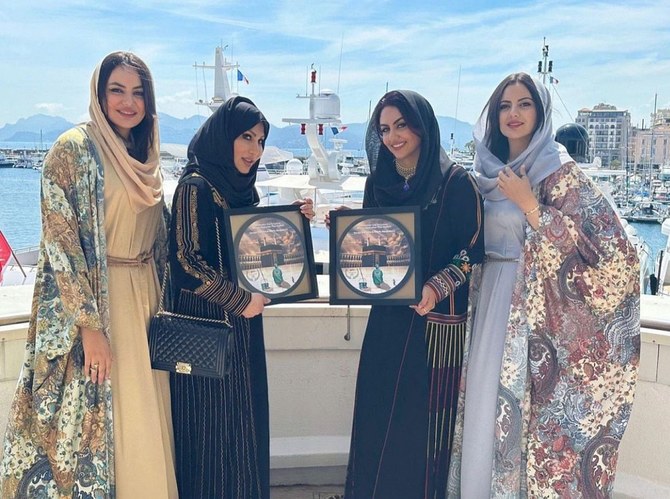
JEDDAH: Saudi film “Wa Isjod Wa Iqtareb” (“Prostrate and Draw Near”) won the “Animation That Matters” award during the Animaze Animation Day event at Marché du Film, the industry networking section of the Cannes Film Festival.
Directed, produced, and written mother-daughter duo Suraya Al-Shehry and Nabila Abuljadayel, the film was created via production company Suraya Productions and explores the period of time during the COVID-19 pandemic when cleaning staff replaced the usual mix of international worshippers at the Grand Mosque in Makkah.
The film integrates traditional art and 2-D animation, but it is its subject matter that makes it unique, according to Al-Shehry.
“In the history of cinema, there has been a noticeable lack of films focusing on Makkah and the Holy Mosque, particularly in the realm of animation. Collaborating with my daughter … on our short animated film has brought me immense joy and a profound sense of fulfilment,” she said.
She added that the film portrays a significant moment in global and Islamic history by showcasing the Grand Mosque devoid of pilgrims, with the exception of the cleaning and maintenance staff who had the unique opportunity to pray there during the pandemic when no one else could.
Abuljadayel reflected on the nearly two-year project, saying: “For me, the best reward was the chance to collaborate with my mother, an experience that transcends any accolade.”
She emphasized that receiving the award aligned with the film’s core message of celebrating shared humanity.
“I firmly believe that what comes from the heart resonates with others, whether expressed through animation or my artwork, and the greatest testimony of that is the success of this film,” she said.
The creative duo seem to be keen to continue their success, with another project scheduled for completion next year.
Ancient castles in Sabya governorate reflect architectural heritage
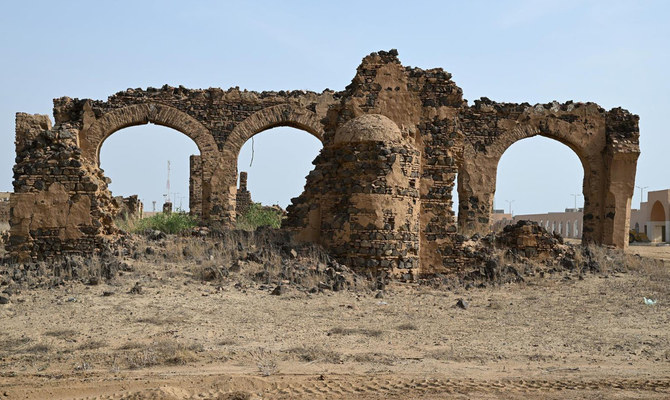
- The Sabya Archaeological Castle has origins that date to the early 20th century
RIYADH: The Sabya governorate in the Jazan region is a treasure trove of archaeological wonders, each with its own unique story.
Among these is the Sabya Archaeological Castle, whose origins date to the early 20th century. The castle, steeped in history, is a must-visit for any archeology enthusiast or researcher.
The castle is situated near Sabya Avenue, within King Fahd Park. It is part of the present city of Sabya, which offers a view of Wadi Sabya.
The Sabya Archaeological Castle, an architectural marvel, boasts spacious rooms with high ceilings and thick walls. The walls, adorned with beautiful geometric and floral patterns, are a testament to the skill of the craftsmen who built them.
Local materials such as volcanic stone, wood, and limestone were used during construction. Some accounts suggest that the clay used in making bricks was sourced from the banks of Wadi Sabya.
The use of volcanic stones of various sizes and shapes in particular gives the castle a unique and captivating beauty. The stones were obtained from volcanoes near the city, including Jabal Akwa, located a short distance northeast of Sabya.
The mosque, situated north of the castle, was also constructed using the same building materials as the castle and other structures in the area. It was intended for prayers and gatherings of religious leaders, dignitaries, and the people of Sabya. Its mihrab, or prayer niche, still stands despite some damage.
Some accounts suggest the presence of remains of other buildings in the vicinity of the castle, opening the possibility of conducting archaeological excavations to reveal more secrets about this site.
The Kingdom’s Heritage Commission is diligently working to preserve the Sabya Archaeological Castle, recognizing its significance as one of the most important archaeological sites in the Jazan region.
Artist captures Saudi charm with digital works
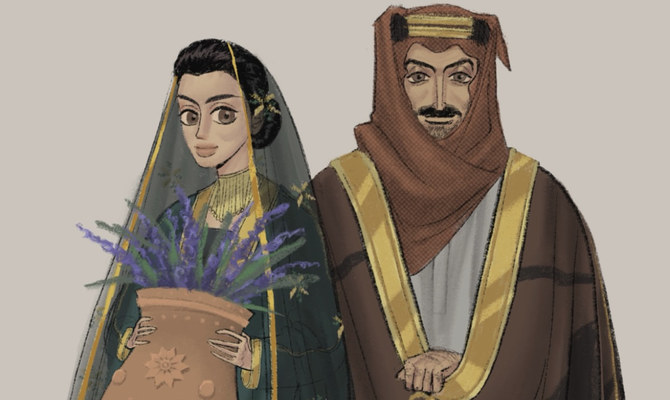
- Ghada Al-Shammari says art can be a means to showcase nation’s rich heritage
RIYADH: Timeless Arabic songs and heartfelt poetry provide the inspiration for Ghada Al-Shammari’s digital art, which showcases the Kingdom’s culture and society.
Al-Shammari's first artwork in 2017 was inspired by a popular Saudi song by Majed Al-Esa called “Hwages,” which means “concerns” in English.
The music video provided a comment on society by using satire, showcasing women driving cars, skateboarding, and playing basketball — activities that at the time were not easily accessible for women.
“I liked how they portrayed women in the traditional Saudi abaya, which motivated me to draw it,” Al-Shammari told Arab News.
For one of her artworks Al-Shammari was inspired by a poem by literary icon Prince Badr bin Abdul Mohsen and popularly performed by the late Saudi singer Talal Maddah.
The drawing depicts a man glancing at a woman who has her eyes downcast, with an oud instrument between them, and the 1980 song title “Forgive Me” written in Arabic text above the illustration.
The Saudi artist said that she tries to capture the poet’s feelings with her artwork, adding: “Romantic songs with descriptions of the poet’s beloved have been particularly inspiring for me.”
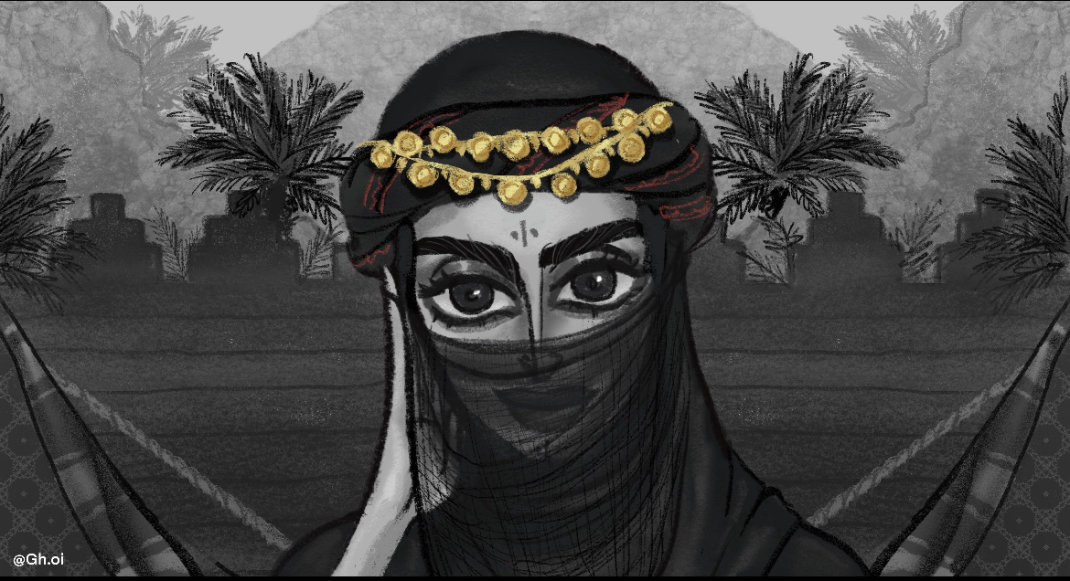
Al-Shammari draws inspiration from the beauty within the Kingdom’s culture. Many of her artworks depict women wearing traditional Najdi-style dresses and gowns with draping silhouettes and glimmering gold headpieces and turbans.
The men are depicted with striking features and wearing traditional garments like the head coverings called ghutra or shemagh, and bisht, the men’s cloak commonly worn in Saudi Arabia and other Gulf countries.
“Saudi culture and traditions have significantly impacted my work. Growing up, I used to think of Saudi Arabia as just what was around me in terms of environment, customs, and traditions,” Al-Shammari said.
When she moved from her hometown of Hafar Al-Batin to the capital Riyadh, Al-Shammari said her friendships and acquaintances showed her a new world of ideas that elevated her artistic vision.
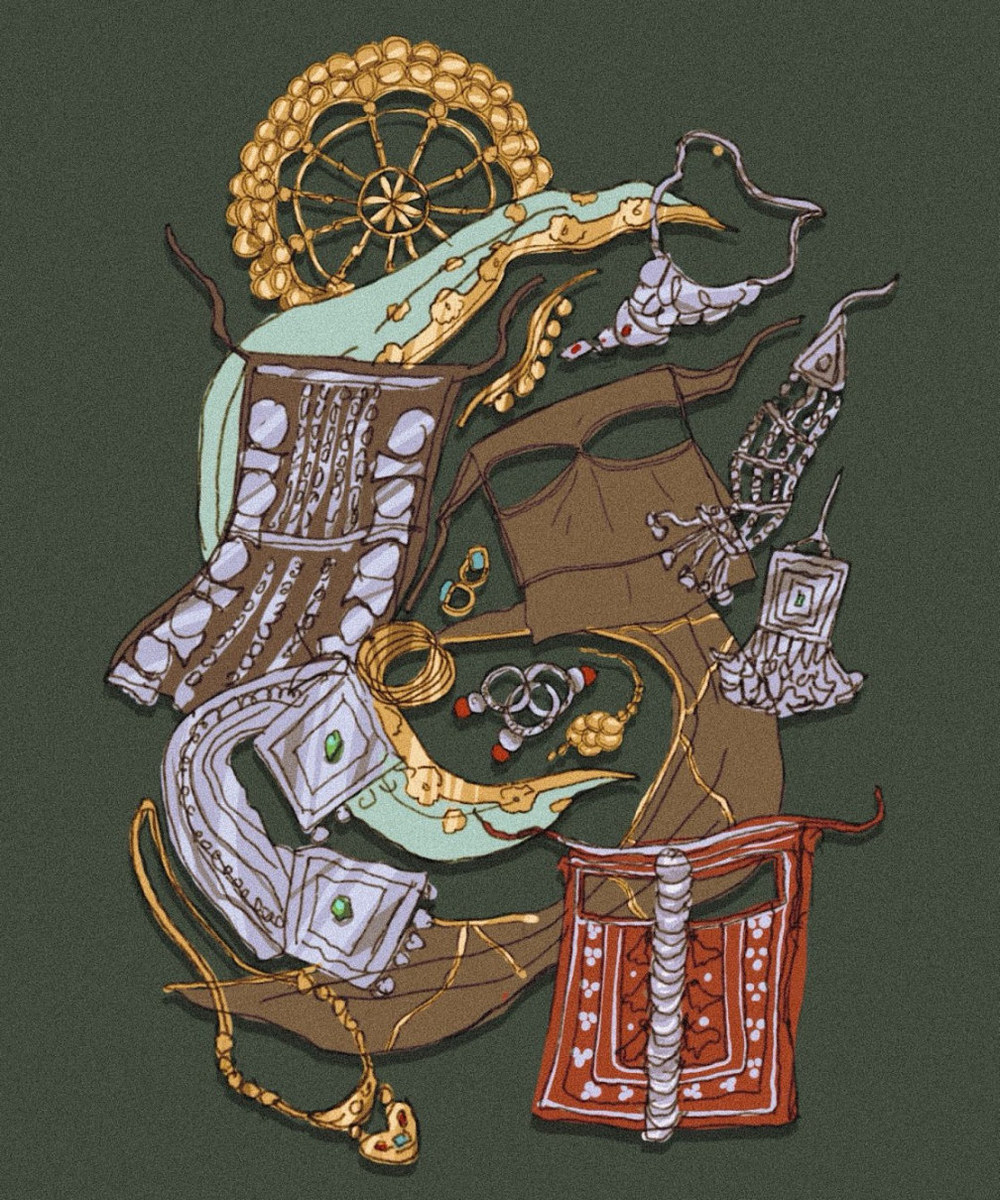
She added: “They shared stories about their region, important landmarks, and fascinating tales that were unique to their areas. This motivated me to learn more about my country and enjoy drawing the diversity and differences I discovered in my artworks.
“Saudi Arabia is full of exciting things, and its diversity is what fascinates me the most. Each region has its own heritage, traditions, architecture, and unique dialect, which makes me eager to learn more and create works that reflect this beautiful diversity.”
Al-Shammari said she selects particular color combinations to evoke the emotions she aims to convey, opting for brighter colors for her cheerful and vibrant works.
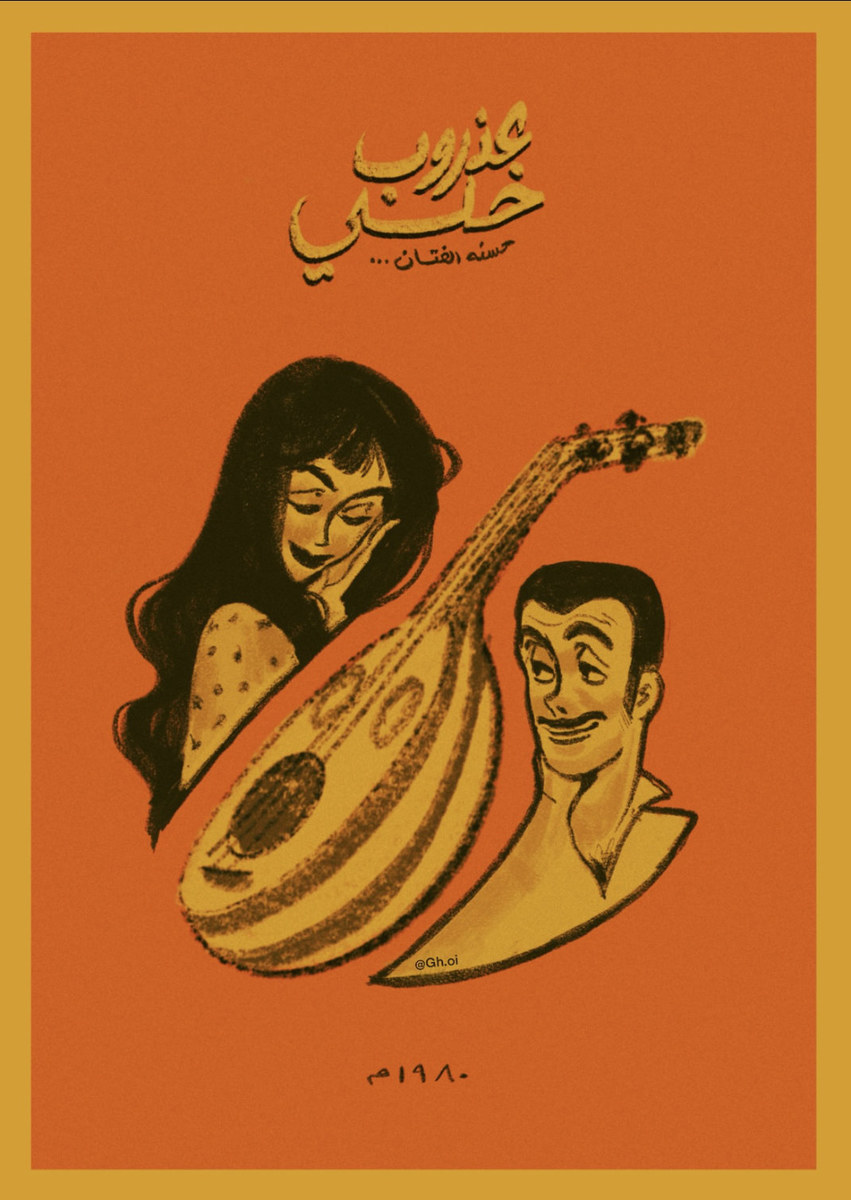
Al-Shammari graduated from the College of Arts and Design at Princess Nourah bint Abdulrahman University with a bachelor’s degree in fine arts.
She added: “Through this specialization, I discovered many artistic and historical aspects, learned about various artists, and got to understand their ideas and philosophies, which transformed my perspective of my work.”
Her love of art began as a child when she would draw characters from her favorite anime and cartoons.
“I started focusing on drawing from an educational perspective at the age of 12 through YouTube tutorials on drawing anime and cartoons, which sparked my artistic journey,” Al-Shammari said.
She added that art is important as it showcases the cultural aspect of a country and its heritage, conveying its history and traditions that help define life in the past and present.
She said: “It serves as a way to preserve and transmit this heritage from one generation to the next, seeking to document knowledge and memories.
“Additionally, from an economic standpoint, art is considered a means to attract tourists interested in discovering the country and its civilization.”
For more information on the artist, visit her Instagram @gh.oi.
Saudi’s ‘Norah’ receives the Special Mention accolade at Cannes
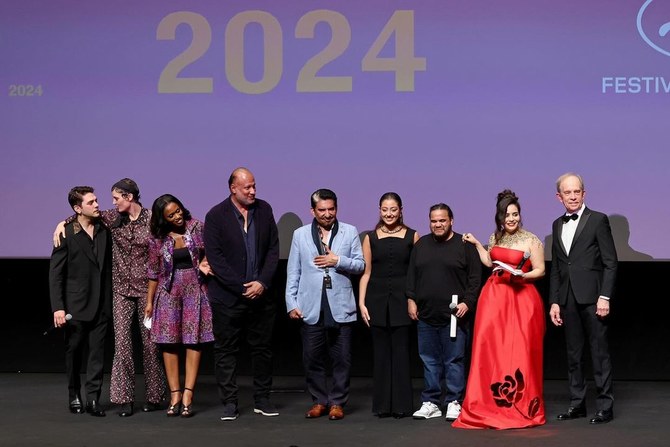
DUBAI: Saudi film “Norah,” starring actress Maria Bahrawi, this week received the Special Mention accolade, which recognizes films for outstanding achievements, at the 77th Cannes Film Festival’s Un Certain Regard awards.
The cast and crew, accompanied by director Tawfik Al-Zaidi, stepped onto the stage to accept the accolade in front of a full house.
The film, shot entirely in AlUla, is set in 1990s Saudi Arabia when conservatism ruled and the professional pursuit of all art, including painting, was frowned upon. Besides Bahrawi, the movie also stars Yaqoub Al-Farhan and Abdullah Al-Satian. It follows the story of Norah and failed artist Nader as they encourage each other to realize their artistic potential in rural Saudi Arabia.
“Norah” had its official screening at the festival on Thursday, becoming the first film from the Kingdom to screen as part of the official calendar at the event.
The movie was backed by the Red Sea Fund — one of the Red Sea Film Foundation’s programs — and was filmed entirely in AlUla in northwest Saudi Arabia with an all-Saudi cast and a 40 percent Saudi crew.
Un Certain Regard’s mission is to highlight new trends in cinema and encourage innovative cinematic works.
Chaired by Canadian actor, director, screenwriter and producer Xavier Dolan, the jury included French Senegalese screenwriter and director Maimouna Doucoure, Moroccan director, screenwriter and producer Asmae El Moudir, German-Luxembourg actress Vicky Krieps, and American film critic, director and writer Todd McCarthy.
Chinese director Guan Hu’s “Black Dog” won the top prize in the Un Certain Regard section.
Marking Guan’s debut at Cannes, the film follows a former convict who forms an unexpected bond with the titular animal while clearing stray dogs in his remote hometown on the edge of the Gobi Desert.
The jury prize was awarded to “The Story of Souleymane,” directed by Boris Lojkine, marking his return to the festival after a decade since his 2014 feature “Hope.”
The film portrays the journey of a Guinean food delivery man who must create a compelling narrative for his asylum application interview in Lyon within a two-day timeframe.
Dave Chappell says support for Gaza war is result of ‘antisemitism in the West’ at Abu Dhabi show
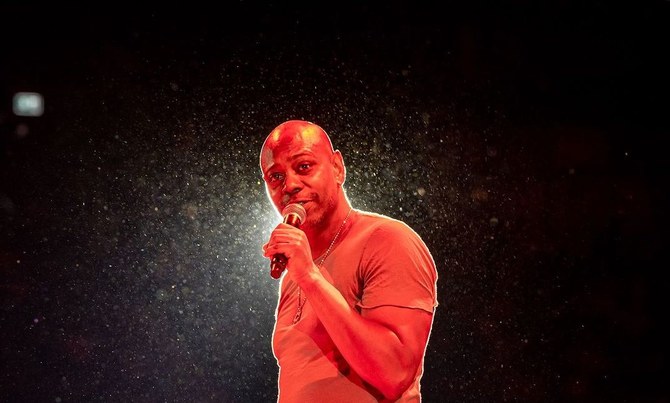
DUBAI: US comedian Dave Chappelle performed to a packed audience at Abu Dhabi’s Etihad Arena on Thursday as part of Abu Dhabi Comedy Week, where he also addressed the war in Gaza.
“What is happening in Gaza is a direct result of antisemitism in the West,” he said on stage.
“If you are in America, the best thing you can do is to make American Jews feel safe, feel loved and supported so they can know they don’t have to support a country that is committing genocide just to feel safe,” he added.
Chappelle previously slammed the Israeli bombing of Gaza, as well as the US support for it, at a show in Boston in October.
According to people in attendance, an audience member asked Chappelle to shut up, which sparked a heated response from the comedian.
“You can’t take tens of billions from my country and go kill innocent women and children and tell me to shut the f--- up,” he said, according to the Wall Street Journal.
Some members of the crowd began chanting “free Palestine,” to which Chappelle replied: “You are damn right, free Palestine.”




